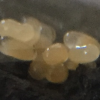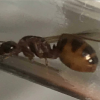Updates Here (images are replaced every week, more or less; see notes for changelogs and news)
Most recent update.
September 13: Same news as below.
September 2: Experiment continues per plan. 2 months is not enough data, extended test duration. Also there's too much to display as pictures, I took a summary screenshot, which is posted below this text but I've also attached the file I am using, which has all my data so far. It's 20 pages long so good luck sorting through my unorganized mess. But feel free to download it, I'll update it as often as I update this post.


Past Notes:
August 21: All is going to plan. I was out of the state for a week so the feeding was a bit delayed. Of course, I am going to match this delay for the other colonies to keep everything constant. I now have nearly 2 months of data for the oldest colonies. Once the rest catch up I can compile a preliminary report. I'm going to extend the study another 2-3 months for more data. Thank you to all the members contributing and following this study. After this one is over we have much more variables to test.
August 10: All is going to plan. Three queens died so far. No explanation. I've changed labels to include a letter before the unique tracking number for other people to join in the study (e.g. TN-TET-IMMI-08-01-D-YYY). It'd be nice to have a standard methodology for ant keepers to record their data and make it easy to consolidate and convert data into graphs. Working on the formulas right now but it'll need a bit more work before I have something I can give to anyone and they'd be able to use it. All colonies that have workers were fed today since I'll be gone next week starting today.
July 23: 001 and 002 completely CLEANED the piece of glass I added honey to yesterday. It broke my heart to think of starving them until Wednesday so I gave them more honey and a fruit fly. The workers immediately gathered around the honey and even the queen came over, pushing aside one of the workers to drink the honey herself. All colonies will receive the same amount of food and follow the same procedure in regards to feeding schedule. I've added a chart keeping progress of what I'm feeding them - you can see that I will feed all colonies 3mg of honey two days after I observe the first workers, and more honey and a fruit fly the day after. I will confirm measurements once the mg scale arrives. If anyone has recommendations for a good routine diet, please let me know. I want to maximize production and it doesn't matter how crazy the diet gets because all colonies will receive the same treatment. The only variable being controlled is heat at this point. My current plan is to clean, weigh and feed every 3 days as you can see in the chart. Interesting note is that colony 001 had 3 pupae July 20th, but now down to 0 today without any increase in worker #. Eaten?!
July 22: All the data represented so far is for July 20. Been busy this weekend and the rest of my time was spent on this http://www.formicult...ack/#entry98095. I was away on a business trip and couldn't take the data for Thursday, but I had a nice surprise on Friday when I had 11 workers for 001 all of a sudden. I've changed a few things in the pictures above as usual to make data easier for me to keep. Smarter work now means less work in the future. Also I fed them today a minor drop of honey. I've ordered the mg scale but it's arriving Tuesday, so no protein until then. Until experiment 01 is complete, all colonies are to be fed the same amount and variety to keep variables constant. Colonies 007 and 008 are added, filed under experiment 03. It's the same parameters as 01, but since they're a different batch I've separated them. 009-015 are arriving next Friday, but the experiments have to be for second and third generation since they already have workers. Same species.
July 16: I confirmed with the original owner that 001 and 002 were one week "older" than the rest. I've adjusted the tables accordingly. The dates on the left hand side are important to keep in mind when tracking progress, especially for the larvae because "day 1" begins at different dates. Some brood that were kept at a high heat have molted into pupae, so it means I missed counting the 2nd, 3rd and 4th instar stages of development. I'm going back to grouping all the stages under "Larvae" as it was before. The main point is to see how fast it takes the egg to develop into worker so I don't think it's a huge disservice to anyone by doing this.
Experiments in progress:
[Current] OR-TET-IMMI-01: The Effect of Temperature on Brood Development for Founding Tetramorium Immigrans Queens (5 samples, 001-005)
[Private] OR-TAP-SESS-02: The Effect of Temperature on Brood Development for Founding Tapinoma Sessile Queens (1 sample, 006)
[Current] OR-TET-IMMI-03: The Effect of Temperature on Brood Development for Founding Tetramorium Immigrans Queens (2 samples, 007;008)
[Current] OR-TET-IMMI-04: The Effect of Temperature on 2nd, 3rd and 4th Generation Brood Development for Tetramorium Immigrans Queens (6 samples, 009-014)
[Upcoming] OR-TET-IMMI-05: The Effect of Temperature on 3rd and 4th Generation Brood Development for Tetramorium Immigrans Queens (7 samples, 001-005;007;008)
[Upcoming] OR-TET-IMMI-06: Average Tetramorium Immigrans Colony Relocation Time to New Nesting Grounds: Covered Versus Exposed to Light (14 samples, 001-005;007-0014)
[Upcoming] OR-TET-IMMI-07: Temperature and Humidity Preferences of Tetramorium Immigrans Brood for Optimal Performance (14 samples, 001-005;007-0014)
Completed Experiments:
OR-APA-OCCI-00: The Effect of Temperature on Brood Development for Founding Aphaenogaster Occidentalis Queens (1 sample, 000) - No Data Available, dud queen.
END Updates ----------------------------------------------------------------
Hi guys, beginner/wannabe ant keeper here from Oregon. It's been about a month since I've bought a queen ant but unfortunately she turned out to be infertile (drone nanitics). I will be getting more soon. Here's the link to my first post for buying ants: http://www.formicult...e-world-oregon/
Anyways I find that other than the basic care sheets provided by the very helpful forum members here, there are no other sources for information regarding ant maintenance. I think it's a good opportunity for me to provide the ant keeping community some more information.
The parameters I will be measuring in terms of ant efficiency - this is done on the assumption that ant efficiency, i.e. growth rate, is the best indicator of the ants' well being and happiness, if such a thing exists - are the following: temperature in/out, humidity in/out, diet, substrate material, formicarium material, light exposure and any others that I may think of or be suggested to the possibility of in the future. The single rule I must follow is that I must not knowingly harm my ants in any way shape or form. This means not exposing them to expoy before curing, not cooking them, not dehydrating them, etc. on purpose.
I will not be measuring: ant pheromone levels, fighting ability, any sort of survival abilities, escape speed or anything ridiculous like that.
I won't be doing any double blind studies, but control groups will be thoroughly monitored and the testing will be held to rigid standards. One flaw I can foresee is the fact that I will be using equipment such as temperature probes that may not be laboratory standard. However I will be listing the p/ns and manufacturers of everything I use so that my results can be duplicated. On that note, one of the reasons I am doing this is so that other ant-keepers can use my methods to maximize the growth rate of their ants. Because that's what we all want, right?
My plans right now are 30 queens, preferably 3 species and 10 of each to begin with. I have enough space for housing and I've confirmed that the production output for fruit flies right now is 500/week at 3 cultures. I got enough materials for 12 cultures, but these guys breed like crazy even with just 3. Still testing mealworms right now, I probably need to invest into more farms to equal the dry mass per week as the fruit flies. Since I'm obviously going to need to scale down fruit fly production right now, it'd be nice to gather some more info on larvae/pupating/breeding time these beetles require. So space and food will be enough, especially for just queens at this point.
I've built a heating chamber that based on location of the test tube can heat from 70 to 100 degrees fahrenheit. What I've done for my current queen is slowly monitor her behavior and adjust the temperature accordingly, which has always been up. I keep her at 83-88 degrees fahrenheit right now only because I do not want to exceed 90 degrees without giving her an option to move. I've designed a very small (1"x3"x3") vertical formicarium based on the structures of ant nests found in nature that would allow a temperature gradient of between 75 and 95 degrees fahrenheit, but it requires at least 10 workers for a safe move. Hydration at all levels of the structure and a very small humidity gradient is achieved via a sponge and vertical pour of either clay, grout or ytong. A larger humidity gradient can be achieved with a larger population and subsequent larger formicarium. I do not have humidity data for the current queen because she is in a test tube and I found no immediate need to buy a humidity/moisture sensor.
Anyways this is one hell of a hobby and I will be active in nearly all aspects of ant-keeping. I will be posting all diagrams (crude blueprints) for the formicariums I make, all materials and testing equipment used and all data from growth rate to temperature to the weight of protein sources fed to the ants. Again, the goal is for ant keepers to benefit, learn, and most importantly reproduce the results I get from my experiments, which is not to harm the ants in any way.
As soon as I have at least 10 queens, I will assign the control groups, parameters for testing and begin the study, which will obviously have to be adjusted to take into account the estimated date of the queens' nuptial flights/capture date and other non-standardizing factors. It's no thesis - but it'll certainly be better and more detailed data than what I've been able to find so far.
I will be here for a long time because I have just realized that the things I enjoyed during my childhood actually make me the happiest in life. I've recently started a long career path regarding one of these things and although I did want to become an entomologist, unfortunately they don't pay well compared to what I do now and I needed to go back to school for that. So ant-keeping as a hobby is about the next best thing. I look forward to sharing ant experiences with you guys and I think it'll be a fun journey. One of my dreams right now is to literally have a backyard aquarium (~800 cubic feet) full of ants. I believe that's enough capacity for at least 500,000 ants. If I stop posting without saying I'm done, it means I died.
Thanks for reading guys.
Experiments in progress:
[Current] OR-TET-IMMI-01: The Effect of Temperature on Brood Development for Founding Tetramorium Immigrans Queens (5 samples, 001-005)
[Private] OR-TAP-SESS-02: The Effect of Temperature on Brood Development for Founding Tapinoma Sessile Queens (1 sample, 006)
[Current] OR-TET-IMMI-03: The Effect of Temperature on Brood Development for Founding Tetramorium Immigrans Queens (2 samples, 007;008)
[Current] OR-TET-IMMI-04: The Effect of Temperature on 2nd, 3rd and 4th Generation Brood Development for Tetramorium Immigrans Queens (6 samples, 009-014)
[Upcoming] OR-TET-IMMI-05: The Effect of Temperature on 3rd and 4th Generation Brood Development for Tetramorium Immigrans Queens (7 samples, 001-005;007;008)
[Upcoming] OR-TET-IMMI-06: Average Tetramorium Immigrans Colony Relocation Time to New Nesting Grounds: Covered Versus Exposed to Light (14 samples, 001-005;007-0014)
[Upcoming] OR-TET-IMMI-07: Temperature and Humidity Preferences of Tetramorium Immigrans Brood for Optimal Performance (14 samples, 001-005;007-0014)
Completed Experiments:
OR-APA-OCCI-00: The Effect of Temperature on Brood Development for Founding Aphaenogaster Occidentalis Queens (1 sample, 000) - No Data Available, dud queen.
Attached Files
Edited by Trythis22, September 13 2018 - 9:20 PM.






























